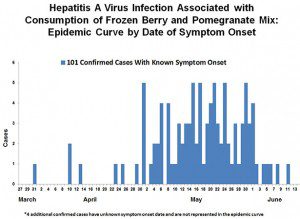

Hepatitis A virus is a member of the picornavirus family, which also contains poliovirus and rhinovirus. The virion is a naked, icosahedral particle containing a single strand of positive-sense RNA. Infection is typically acquired by ingestion of food contaminated by feces containing the virus. In one scenario, food is contaminated by an HAV-infected food handler who does not practice good hand hygiene. After ingestion, the virus enters the gastrointestinal tract and then passes to the blood. It then replicates in the liver leading to jaundice and elevated serum levels of liver enzymes. After replicating in the liver, HAV passes into the intestine via the bile canaliculi and is then shed in feces. The incubation period of the disease is on average 4 weeks, but infectious particles are present in feces about two weeks before the onset of clinical symptoms. The virus is most likely to be transmitted during this period as the infected individual does not display clinical symptoms.
There are six genotypes of HAV that circulate worldwide. According to the CDC, the virus strain causing this outbreak is HAV genotype 1B, which is often found in North Africa and the Middle East but is rarely isolated in the Americas. Genotype 1b caused a 2013 European outbreak linked to frozen berries, and a 2012 British Columbia outbreak in which a frozen berry blend was implicated. In the BC outbreak the berry blend contained pomegranate seeds from Egypt. This is likely why Townsend Farms recalled the berry mix when they found that it contained pomegranate seeds processed in Turkey.
A well-known outbreak of hepatitis A infection took place in November 2003 among the patrons of a single Pennsylvania restaurant. In this outbreak of 601 patients, 3 died and 124 were hospitalized. Infection was caused by consumption of salsa which had been prepared with green onions grown in northern Mexico that were contaminated with hepatitis A virus.
Transmission of HAV infection can be prevented by proper hand hygiene, avoiding hand contamination with fecal matter, or by using available vaccines.
PS if you buy whole pomegranates, don’t miss this video by the Produce Picker on how to cut them.

It’s amazing this virus can survive freezing.
Most viruses remain infectious after freezing. That’s how we store virus stocks in the lab – in a minus 70 degrees Celsius freezer. HAV can also survive acid (passage through the stomach) and all the enzymes and bile in the digestive tract.
HAV is particularly hardy in the environment, and is able to survive on surfaces anywhere from a few days to a few weeks, depending on temperature, humidity, etc. http://www.ncbi.nlm.nih.gov/pmc/articles/PMC2094762/table/T2/
HAV continues to be a challenge for us in the food industry, especially when food requiring extensive human handling is sourced internationally.